How To Launch Your First Affiliate Email Marketing Campaign
Affiliate email marketing can boost your income. But launching an affiliate email marketing campaign is not as simple as it sounds. If you want to succeed, you need to plan and be strategic in your efforts.
This article will look at how you can launch your first affiliate email marketing campaign. But first, let’s discuss a few things you need to be aware of before you launch your affiliate email marketing campaign.
Email Affiliate Marketing Mistakes to Avoid
Before you launch a campaign, consider the promise you made to your subscribers. For example, you might have promised to send subscribers a regular monthly newsletter. Or, you might have promised to send your audience content about email marketing.
Whatever promise you made to your subscribers, you need to keep.
Take Digital Marketer as an example. They promise to send emails every Monday with marketing content.
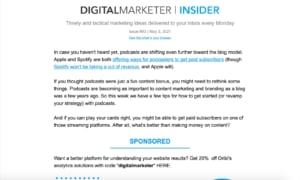
You can’t suddenly go from promising to send regular newsletters about marketing to exclusively sending emails with links to affiliate offers. You’ll only get unsubscribes.
You could send the occasional email with links to affiliate offers. That’s fine. Your subscribers will expect you to want to earn some money. Or, you could include affiliate links in some of your newsletters. That’s also fine. It’s just a case of moderation.
The second thing to keep in mind is that your subscribers need to desire the products you promote. There is no point in promoting products that people don’t want.
If you’re unsure about the type of products or services your subscribers find interesting, ask them. Or create a customer persona and try to identify their pain points and desires. You’ll generally find that the best approach is based on data and insight.
With these two things out of the way, let’s discuss running an affiliate email marketing campaign.
The success of your affiliate email campaign will depend on your planning. I’ll walk you through how to run an effective affiliate email marketing campaign in the following paragraphs.
1.Check If Your Email Provider Allows Affiliate Links
Before you send emails containing your affiliate links, you should verify your list. Then, make sure your email provider allows you to run affiliate marketing campaigns. Some email providers discourage affiliate marketing because they are concerned about deliverability rates. Others ban the inclusion of affiliate links in emails entirely.
Don’t risk losing your email account or your mailing list by breaking the rules.
The best way to confirm whether your email provider allows affiliate links is to ask them or search for the FAQ. You can contact the company’s customer support if the information is not included within the terms of service.
2. Choose a Good Affiliate Network
Assuming that you’re allowed to run an affiliate email marketing campaign, you need to find products to promote. The process is straightforward: join a company’s in-house affiliate program, or join an affiliate network.
Affiliate networks may work better for you if you’re just starting. The network acts as the intermediary between you and the company, so you can be assured that you’ll get paid correctly and on time.
Affiliate networks often offer more accurate tracking of affiliate clicks and can provide you with better reporting. There are some exceptions to this.
Affiliate networks also allow you to promote products from multiple merchants. You can manage everything from a single dashboard.
These are some of the best affiliate networks:
- ShareASale
- ClickBank
- JV Zoo
- CJ Affiliate (formerly Commission Junction)
- Amazon Associates
- eBay Partner Network
- FlexOffers
- Pepperjam
- Rakuten Marketing (formerly Linkshare)
Ensure the merchants you choose to sell products or services related to your niche.
For example, if you’re a software blogger, JV Zoo might be your best bet. Many software companies list deals on the platform.
Once you’ve picked your program, review the commission rate, conversion rates, Earnings Per Click (EPC), and the refund rate. The EPC is especially important, as it will provide you with a sense of how much money you will make from promoting a product.
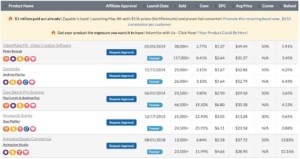
Most affiliate networks share this information with affiliates.
An in-house affiliate program might not share this data. If you can’t find the data, I recommend you send an inquiry. The company might not respond to your request, but there’s no harm in asking.
3. Design Your Campaign
Once you’ve found a product, the next step in the process is to choose how long you want to promote an offer. Fundamentally, you have two options:
- Send one email to subscribers promoting the offer
- Send multiple emails to subscribers as part of a campaign
There are pros and cons to both approaches. For example, if you only send one email to subscribers, you’ll make fewer sales. On the positive side, you’re less likely to get unsubscribes, which will happen when people feel you are bugging them.
If you decide to send multiple emails, you’ll make more sales but annoy your subscribers.
AppSumo is an example of a company that only sends one email using a standardized template. They decided that approach worked best because they didn’t want to lose subscribers. Many other affiliates run campaigns. Ultimately, you’ll need to decide which approach is best for your business.
Send Multiple Emails
If you choose to run a campaign, consider how to sequence your emails. For example, you could use the “Product Launch Formula.” You send three emails, and then you launch your promo.
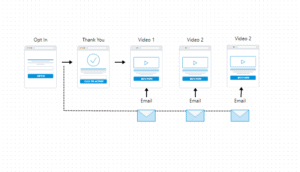
Source: Funnelytics
Jeff Walker developed the Product Launch Formula. The sequence works great for affiliate marketing campaigns.
Here’s an example of an affiliate marketer using this approach to promote his product. The email below is the first of the series.
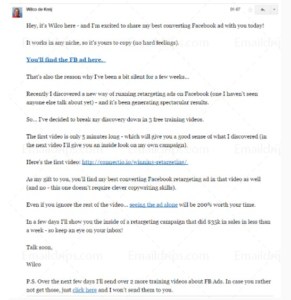
You can see that Wilco outlines what subscribers can expect in the first email. He then shares a link to the landing page with a video.
Each email in the sequence needs to lead into the next. The idea is to build anticipation for the offer you are promoting. That way, you can maximize the conversions. If you plan to
Sending a single email is more straightforward.
The final thing you should consider is what you can do to maximize conversions.
The Bonus Funnel
One strategy you can use to improve your conversion rate is to create a bonus funnel. A bonus funnel is where you add bonuses to the affiliate offer for people who purchase through your link.
The way a bonus funnel works is straightforward. You promote your offer through your email and share your custom bonuses. You then create a landing page where you send your subscribers.
You can use a design like the one below to promote your bonuses. Your bonuses will incentivize people to use your link and boost conversions.
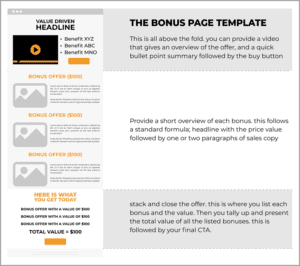
Source: Jeff Bullas
The bonuses you provide to subscribers should be useful for anyone purchasing the product or service you’re promoting. For example, if you were promoting a camera as an affiliate, you might create a video training series that shows people how to make the best use of the camera.

Russell Brunson, the founder of ClickFunnels, was one of the first people to use stacked bonuses to increase conversions. You’ll see he uses this approach on almost all his sales pages, even when those sales pages promote a free product.
If you choose, you might send them through your bonus funnel to a webinar, where you share information about the product or service you are promoting. For an expensive product, you might try to get them to join a virtual meeting.
4. Write Your Email Copy
Once you’ve defined your campaign, it’s time to write the email copy for your affiliate email marketing campaign. The email you send should have one purpose; to get people to click on that affiliate link.
If you’re serious about maximizing your conversions, I recommend that the only thing you do in the email is to promote the product. If your email has multiple goals, for example, promote a product and get people to visit your blog, you’ll get a lower conversion rate.
AppSumo is a great example of a company with a clear framework you could imitate when promoting a product.
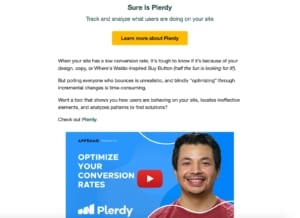
The emails have three Calls to Action to the sales page.
Making Sense of Cents is another company you might want to imitate. In the example below, Michelle is promoting an affiliate marketing course. She starts by sharing her story. She then discusses her fears and overcomes the objections.

This copywriting strategy is a great way to convince people they need the product or service you are promoting.
The final example I want to touch on is the bonus funnel. In the email example below, you can see how the writer stacks up the value of the bonuses. Stacking up the bonuses, and showing the value of the offer you have put together, is a great way to incentivize action.
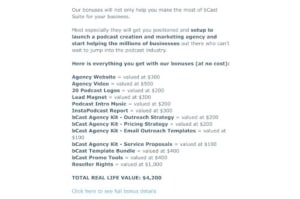
If you plan to use a bonus funnel, I recommend you take this approach.
5. Measure and Analyze Your Performance
Your job doesn’t end once you’ve automated your campaign. You’ll need to monitor the performance of each affiliate email sequence and each individual email, so you’ll know which ones work. Look at your email open rates, click-through rates, and unsubscribe rates. Track all of your subscribers’ interactions with your emails.
Most importantly, pay attention to your affiliate commissions. That’s the most important metric for you as an affiliate email marketer. If an affiliate email sequence has high open rates but doesn’t bring in conversions, that means you need to change something in that email to encourage readers to push through with the purchase.
If you continually analyze your affiliate email campaign, you can determine which emails and email sequences you should retain, discard, tweak a bit, or overhaul.
Wrapping up
If you’re a publisher, you should seriously consider venturing into affiliate marketing to earn some extra income if you haven’t already. Your email list is one of the most powerful tools you have, so why not make good use of it? Instead of just sending marketing emails to your subscribers, you can also send them your affiliate links to generate conversions.
But there’s a right and wrong way to conduct an affiliate email marketing campaign. I’ve laid out the process you should follow. Now it’s up to you. It can take time and effort to start seeing results, so put the work in and be strategic in all that you do. If you do, you’ll soon see those affiliate commissions coming in!



Leave a Reply
Want to join the discussion?Feel free to contribute!